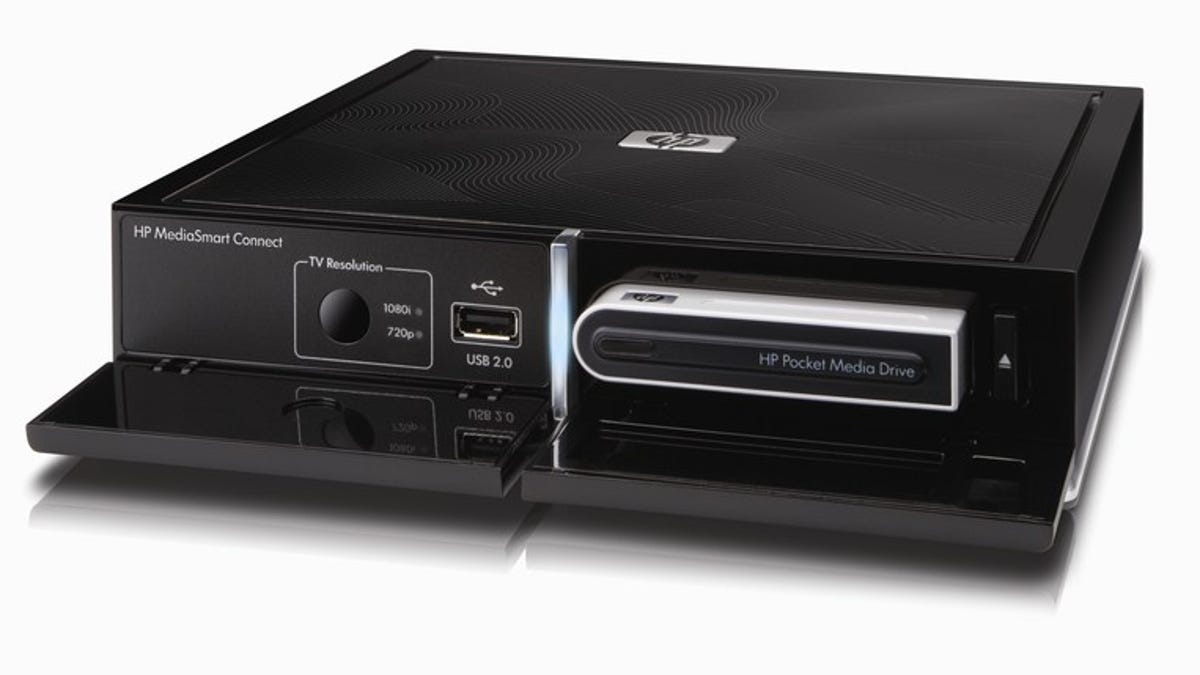RIP standalone network media players
Manufacturers are finally figuring out that this category never had much appeal as a standalone product.

Call it a one-two punch: Monday's news that HP is discontinuing its MediaSmart Connect line follows Friday's report that Linksys' line of Media Center Extenders is also on its way out.
While two announcements doesn't a trend make (you need three for that), I'm hopeful that one of my consumer electronics wishes is finally coming true. We may be seeing the end of the standalone network digital media player. And I say "good riddance." This is a product category that never really should've existed in the first place.
To be clear, I'm not talking about digital music players--those products like
No, I'm talking about video-enabled digital media adapters. (Which brings me to gripe No. 1: the industry couldn't even agree on a common terminology. The products were alternately known as digital media adapters, digital media players, network media streamers, set-top boxes--or some amalgamation thereof.)
There were three big reasons the product category continued to languish in the enthusiast realm and never really went mainstream. The first was price--the boxes were invariably priced north of $300. The second was complexity. By definition, the units required a degree of home-networking knowledge. Often, you'd need to run a program on your PC (acting as a server), which the media receiver would then have to "see" on the network. Even for seasoned tech geeks, it was often a daunting process.
A lot of us thought it would be over once Apple entered the game with
Part of the reason, no doubt, was the third big problem with digital media players: "box fatigue." People already had three or more boxes under their TV: a cable/satellite box, a game console, and a DVD player. (Add to that, in some households, a second or third game console, and perhaps a VCR or standalone TiVo.) "Why can't this functionality be built into one of the boxes I already own?" was the inevitable refrain.
Of course, Microsoft and Sony were all too happy to answer. Those companies were busy one-upping each other with the value-added features to their new game consoles, the Xbox 360 and PlayStation 3. And in fact, both of those consoles are, by and large, excellent digital media players. The 360 is both a full-on Windows Media Center Extender (so it can be used to watch live and recorded TV from a properly configured Windows PC) and a "vanilla" network media player (which can access most standard audio, video, and photo files from a networked PC). The latter is true of the PS3 as well; in fact, I'd argue the PS3 is actually a more robust media streamer than the 360. Recent firmware updates adding DivX compatibility (albeit with some limitations) have made these game consoles even better media streamers than when they originally launched.
However, all of those other problems overshadowed the elephant in the room. Manufacturers never acknowledged the true use for these products: pirated content. With the exception of home movies, the only video files you'd really want to stream from a PC to your TV were all manner of illicit content: ripped DVDs and videos from BitTorrent. That left mainstream manufacturers unable to openly market these products for the intended audience.
Effectively, the market was ceded to boutique manufacturers who were happy to cater to the die-hard streamers and their "don't ask, don't tell" video collections. It's no accident that
So where does that leave non-geeks? Those who don't even want to bother with networking can opt for a growing selection of USB-friendly plug-and-play media adapters. Connect one to a TV, plug in a USB drive full of media files, and you're good to go. Apple fans will love the Apple TV's friendly and easy-to-use interface, as well as the fact that it integrates perfectly with iTunes.
Savvier users, meanwhile, will find a good selection of jack-of-all-trades boxes that handle media streaming, plus a whole lot more. In addition to the aforementioned Xbox 360 and PS3, non-gamers should check out the TiVo and Moxi DVRs, as well as the new
And it's that final feature set that's really the sword in the heart of the media streamer movement. The whole promise of the mythical set-top box was that you could access a wide variety of content, digitally, without the hassle of tapes or discs. The need to set up your PC as a server and then link it with the living room box was something of a step backward--especially when you were responsible for somehow loading up your PC with space-hungry video files as well.
But now, thanks to cloud-based video services like Netflix, iTunes, Amazon, and YouTube, we're closer, in my opinion, to what the masses really wanted in the first place. Yes, the selection still isn't ubiquitous, and the pricing models might not be perfect. But it's a big step in the right direction.
What do you think: Have you think a standalone digital media player is a worthwhile product? Are the media streaming functions of the Xbox 360 or PS3 robust enough for you? Or is a Netflix or Amazon-compatible Blu-ray player more your speed? Share your thoughts below.

